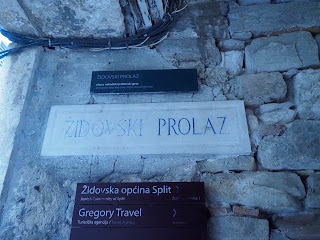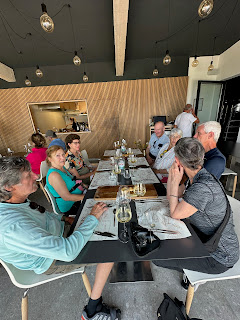Day 12: Split
Breakfast at the Coranaro was amazing and we tried to sample everything even though they had a warning sign at the entrance.
Molly found some "chocolate" bread that looked inviting,

until she ate it and found out that it was squid ink bread. Yuch!
Our guide, Leo, met us in the lobby after breakfast, and we walked outside directly facing the old Roman wall of the city. Leo had a degree in architecture and was a wealth of knowledge about the architecture and history of Split.
Split's history began as the Greek colony of in the 3rd or 2nd century BCE. It was a trading post founded by Greek settlers from the nearby island of Vis.
With the rise of the Roman Republic, the region came under Roman rule after the Illyrian Wars (229 and 219 BCE). The nearby city of Salona (modern-day Solin) became the capital of the Roman province of Dalmatia and a major Roman city.
The most significant event in Split's ancient history is the construction of Diocletian's Palace. Roman Emperor Diocletian, who was born near Salona, began building this opulent and heavily fortified palace as his retirement residence around 295 CE, completing it by 305 CE. The palace was not just a residence; it was a sprawling complex combining an imperial home, a military fortress, and a fortified town, covering an area of about 30,000 square meters. It was built using local limestone from Brač island, with marble and granite imported from Egypt, Greece, and Italy.
Our first stop once we entered the walls of the old city was to visit the old synagogue and to learn about the Jewish influence in Split.
The earliest evidence of Jewish presence in the region dates back to the 3rd century CE in Salona the Roman capital of Dalmatia, just north of Split. Archaeological finds, including menorah-decorated artifacts, oil lamps, and tombstones, confirm a thriving Jewish community there.
When Salona was destroyed by the Avars and Slavs around 614 AD, its inhabitants, including Jews, sought refuge within the fortified walls of Diocletian's Palace. This pivotal moment marks the beginning of continuous Jewish presence within what would become the city of Split. There are even traces of menorahs inscribed on stone blocks within the palace, hinting at early places of worship.
A significant turning point for the Jewish community in Split came in the late 15th and early 16th centuries with the arrival of Sephardic Jews fleeing persecution during the Spanish and Portuguese Inquisitions. Split at that time was under Venetian rule, offering a relatively tolerant environment compared to much of Europe. While ghettos were common elsewhere, Split's Jews often lived integrated within the city walls, particularly in the northwestern part of Diocletian's Palace, which became known as the Jewish Quarter.
Jewish merchants, physicians, and tailors played a crucial role in Split's economy. Notably, Daniel Rodriga (or Rodriguez), a Spanish Jew, was instrumental in establishing Split as a major trading port in the 16th century. He initiated the construction of a lazaret (quarantine station) and promoted a safer land route for trade between the Ottoman Empire and Venice, enriching both the Jewish community and the city as a whole.
During the Venetian-Ottoman wars, Split's Jews demonstrated their loyalty. In the 1657 Turkish siege, they famously defended a tower in the northwest wing of Diocletian's Palace, which subsequently became known as the "Jewish Fort" (Posto degli Ebrei).
While generally more tolerant, the Venetian authorities did impose some restrictions, such as requiring Jews to wear specific colored hats and limiting their ability to own real estate. However, Split's Jewish community often managed to circumvent harsher "ghetto" rules common elsewhere.
The Napoleonic era (early 19th century) brought a brief period of greater freedom, including the abolition of any remaining ghetto restrictions. When Split returned to Austrian rule, Jewish laws valid in Austria were gradually applied, culminating in full emancipation in 1873.
This period saw Jews continue to contribute to civic life. Vid Morpurgo (1834-1911), from a prominent Ashkenazi family, was a notable figure. He founded Split's first lending library, established a bank, and played a significant role in the Croatian national movement. His former bookstore, still active today, stands as a testament to his legacy.

The current Split Synagogue, located in Židovski prolaz (Jewish Lane), was established in the 16th century by converting the second floor of two attached medieval houses. It is one of the oldest active Sephardic synagogues in Europe, a testament to the community's longevity. An earlier synagogue from Roman times was reportedly destroyed in a fire in 1507. It has undergone renovations, notably in 1996 and 2015. In addition to being an active synagogue, it also serves as the headquarters for the Jewish community of Split (Židovska općina Split).

We were introduced to Albert, the defacto leader of the present day Jewish community. He was a very colorful and funny spokesman for the community. Before being a comedian (he could have easily headlined in the Borscht Belt), he was a cameraman for a local tv station. He explained to us that, though there is no rabbi (they share a rabbi from Zagreb with several other cities), they meet on Friday nights primarily to eat but they continue to keep the culture alive. He told a funny story about a rabbi from the US that was considering being the communities rabbi. He did a Shabbat service that lasted about 1 1/2 hours until Albert cut him off because he was losing the congregation. The rabbi left because the community wasn't "Jewish enough". Albert's response, " better some than none".



He also told us stories about his family during WWII and his father's time with the partisans.
On the eve of World War II, Split's Jewish community numbered around 300 members. The war brought immense tragedy. While under Italian occupation, some restrictions were imposed, but large-scale deportations were largely avoided. However, when Italy capitulated and German and Ustaše (Croatian fascist) forces took over, the situation became dire. In June 1942, the synagogue was attacked, looted, and sacred texts were burned in the main square. Many Jews from Split joined the anti-fascist resistance (Partisans).Those who couldn't flee or join the resistance were subjected to deportation. Approximately half of Split's Jewish population perished in the Holocaust, deported to concentration camps like Jasenovac.
After the war, the community was severely depleted, numbering around 163 in 1947 and dwindling further to about 100 by the turn of the 21st century, with many migrating to Israel.
The Jewish Community in Split Today
Despite the profound losses of the Holocaust, the Jewish community in Split continues to exist, albeit small (about 40 now). They are actively involved in preserving their rich heritage and culture.
 |
| Memorial in the synagogue to Holocaust victims |
Just outside the synagogue was the Morpurgo Bookstore, located on Narodni trg (People's Square). It was founded by Vid Morpurgo in 1860, and it is one of the oldest continually operating bookstores in Europe The Jewish bookstore is a significant historical landmark connected to the Jewish community.
 |
| Narodni trg (People's Square) |
 |
| Shops built into the old Roman walls of the Diocletian Palace |
Diocletian, the Roman Emperor who ruled from 284 to 305 CE was a monumental figure in Roman history, famous for bringing stability to the empire after a period of intense crisis and for his sweeping reforms. He was born in Solona (near Split) to peasants and rose through the ranks due to his skill and leadership. He served under various emperors before ultimately being proclaimed emperor by his troops in 284 CE after the death of Emperor Numerian.
He made many positive reforms in Roman government in areas of taxation, bureaucracy, economy and the military. Establishing the Tetrarchy or Rule of Four was his most significant reform. Recognizing that the vast Roman Empire was too large and complex for a single ruler, Diocletian established a system of shared power.
He is probably best remebred, though, for his brutal in the persecution of early Christians.Beginning in 303 CE, he initiated the Great Persecution of Christians, the largest and most severe official persecution in Roman history. Churches were destroyed, scriptures burned, and Christians who refused to sacrifice to the Roman gods faced torture and execution. This persecution, however, ultimately failed to eradicate Christianity.
Diocletian is unique among Roman emperors for being the first to voluntarily abdicate power. Weakened by illness, he stepped down on May 1, 305 CE, and insisted that Maximian do the same.He retired to his magnificent palace on the Dalmatian coast, in his homeland, which eventually became the core of the modern city of Split. Legend has it he spent his retirement tending to his cabbage garden, famously remarking that he would not give up his peaceful life there for the troubles of imperial rule. He died in his palace in 311 or 312 CE. Although his carefully constructed tetrarchic system began to unravel after his abdication, his reforms laid the groundwork for the later Roman Empire and the Byzantine Empire in the East.
Diocletian, after a transformative and stabilizing reign, chose Split, an idyllic spot on the Adriatic to build his retirement palace. Constructed between 295 and 305 AD, what we now call Diocletian's Palace was less a palace and more a fortified imperial city. Its grand scale, military-like layout, and opulent residential quarters were a testament to Roman engineering and imperial power.
 |
| One of 4 remaining towers of the Diocletian Palace |
 |
| Leo explaining the architecture of the palace |
 |
| Diocletian Palace Cellars |
 |
| Prior to excavation |
 |
| PAinting of Diocletian Palace from the 1800s |
When Salona was sacked by Avars and Slavs around 614 AD, its Roman inhabitants fled, seeking refuge within the sturdy walls of Diocletian's Palace. This mass migration transformed the emperor's private residence into a vibrant, continuously inhabited settlement.
The once-grand imperial chambers were repurposed, alleys formed, and new structures emerged within the palace walls. The emperor's mausoleum was consecrated as the Cathedral of St. Domnius, and the Temple of Jupiter became the Baptistery. This organic evolution of a Roman monument into a medieval city is what makes Split so unique and earned it UNESCO World Heritage status.
 |
| St Dominus |
 |
| Sphinx brought from Egypt outside St Dominus |
 |
| Medieval alleys |
Our tour of Split ended just in time for Mario to drive us into the hills above Split to the Sikuli Winery for wine tasting and lunch.
The views from the winery were beautiful.
Starting with a Rose
we progressed to a white, red, and dessert wine, all before 3 in the afternoon (5 O'Clock somewhere). Each wine had another dish paired with it.
 |
| This is Suzy's picture of our dessert (though I put her up to it) |
We were pretty stuffed from dinner and decided to pass on an evening meal in lieu of gelato. Tomorrow we will be taking a hike through the hills in Hvar.






































No comments:
Post a Comment